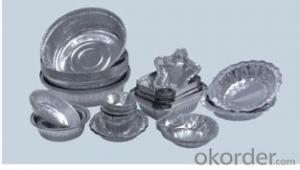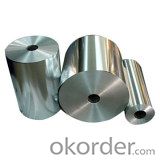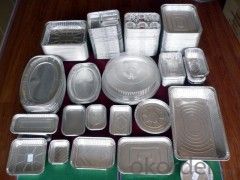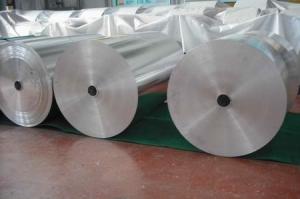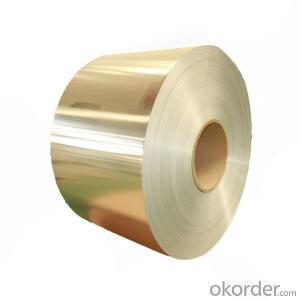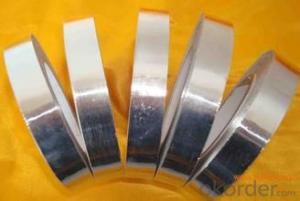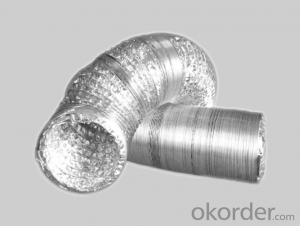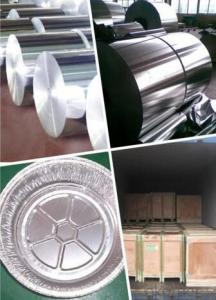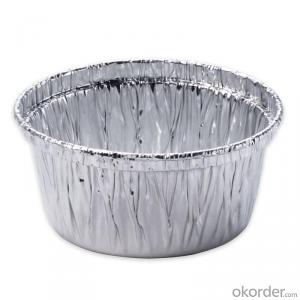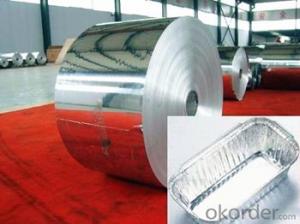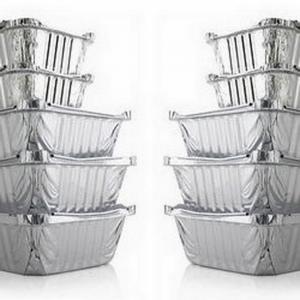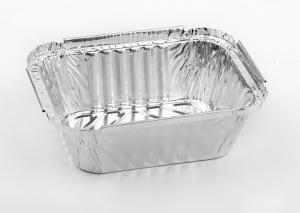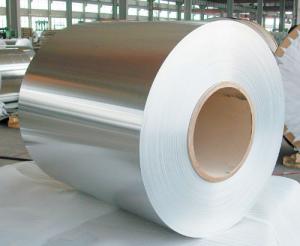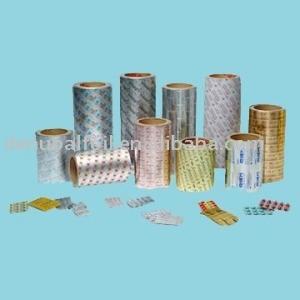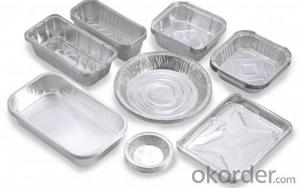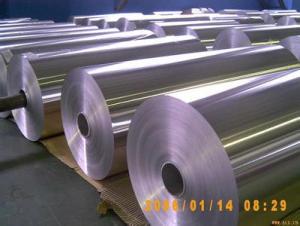8021 Aluminum Foil for Use Container
- Loading Port:
- China Main Port
- Payment Terms:
- TT OR LC
- Min Order Qty:
- -
- Supply Capability:
- -
OKorder Service Pledge
OKorder Financial Service
You Might Also Like
Aluminium foil acts as a total barrier to light and oxygen (which cause fats to oxidise or become rancid), odours and flavours, moistness, and germs, it is used broadly in food and pharmaceutical packaging. The purpose of aluminium is to make long-life packs (aseptic processing|aseptic packaging) for drinks and dairy goods, which allows storing without refrigeration. Aluminium foil containers and trays are used to bake pies and to pack takeaway meals, ready snacks and long life pet foods.
Aluminium foil is widely sold into the consumer market, often in rolls of 500 mm (20 in) width and several metres in length.It is used for wrapping food in order to preserve it, for example, when storing leftover food in a refrigerator (where it serves the additional purpose of preventing odour exchange), when taking sandwiches on a journey, or when selling some kinds of take-away or fast food. Tex-Mex restaurants in the United States, for example, typically provide take-away burritos wrapped in aluminium foil.
Aluminium foils thicker than 25 μm (1 mil) are impermeable to oxygen and water. Foils thinner than this become slightly permeable due to minute pinholes caused by the production process.
Aluminium foil has a shiny side and a matte side. The shiny side is produced when the aluminium is rolled during the final pass. It is difficult to produce rollers with a gap fine enough to cope with the foil gauge, therefore, for the final pass, two sheets are rolled at the same time, doubling the thickness of the gauge at entry to the rollers. When the sheets are later separated, the inside surface is dull, and the outside surface is shiny. This difference in the finish has led to the perception that favouring a side has an effect when cooking. While many believe that the different properties keep heat out when wrapped with the shiny finish facing out, and keep heat in with the shiny finish facing inwards, the actual difference is imperceptible without instrumentation.The reflectivity of bright aluminium foil is 88% while dull embossed foil is about 80%.
We provide a full range of precision aluminum strip for almost any application. We produce aluminum strip in a wide variety of alloys, including clad composites. Our aluminum strip can be produced in standard dimensions or custom made to your special requirements. We produce both imperial and metric units. We manufacture in compliance with the main international specifications, and tighter tolerances or custom tempers are available upon request. We offer various surface conditions, custom finishes (painting, anodizing, embossing), special processing, and multiple packaging options to meet our customer's unique requirements. The following is a summary of our capabilities.
Manufactured in compliance with the main international specifications and standards, including: Aluminum Association, ASTM, EN, and DIN.
We can also manufacture in compliance with other international standards including:ASME, SAE, AMS, AWS, FED, MIL, QQ, ISO, BS, AFNOR, JIS and GOST.
Manufactured in compliance with the main international specifications and standards.
Tighter tolerances are available upon request.
Aluminium (or aluminum; see spelling differences) is a chemical element in the boron group with symbol Al and atomic number 13. It is a silvery white, soft, ductile metal. Aluminium is the third most abundant element (after oxygen and silicon), and the most abundant metal in the Earth's crust. It makes up about 8% by weight of the Earth's solid surface. Aluminium metal is so chemically reactive that native specimens are rare and limited to extreme reducing environments. Instead, it is found combined in over 270 different minerals.The chief ore of aluminium is bauxite.
Aluminium is remarkable for the metal's low density and for its ability to resist corrosion due to the phenomenon of passivation. Structural components made from aluminium and its alloys are vital to the aerospace industry and are important in other areas of transportation and structural materials. The most useful compounds of aluminium, at least on a weight basis, are the oxides and sulfates.
Despite its prevalence in the environment, no known form of life uses aluminium salts metabolically. In keeping with its pervasiveness, aluminium is well tolerated by plants and animals. Owing to their prevalence, potential beneficial (or otherwise) biological roles of aluminium compounds are of continuing interest.
The earliest citation given in the Oxford English Dictionary for any word used as a name for this element is alumium, which British chemist and inventor Humphry Davy employed in 1808 for the metal he was trying to isolate electrolytically from the mineral alumina. The citation is from the journal Philosophical Transactions of the Royal Society of London: "Had I been so fortunate as to have obtained more certain evidences on this subject, and to have procured the metallic substances I was in search of, I should have proposed for them the names of silicium, alumium, zirconium, and glucium."
Davy settled on aluminum by the time he published his 1812 book Chemical Philosophy: "This substance appears to contain a peculiar metal, but as yet Aluminum has not been obtained in a perfectly free state, though alloys of it with other metalline substances have been procured sufficiently distinct to indicate the probable nature of alumina."[69] But the same year, an anonymous contributor to the Quarterly Review, a British political-literary journal, in a review of Davy's book, objected to aluminum and proposed the name aluminium, "for so we shall take the liberty of writing the word, in preference to aluminum, which has a less classical sound."
The -ium suffix conformed to the precedent set in other newly discovered elements of the time: potassium, sodium, magnesium, calcium, and strontium (all of which Davy isolated himself). Nevertheless, -um spellings for elements were not unknown at the time, as for example platinum, known to Europeans since the 16th century, molybdenum, discovered in 1778, and tantalum, discovered in 1802. The -um suffix is consistent with the universal spelling alumina for the oxide (as opposed to aluminia), as lanthana is the oxide of lanthanum, and magnesia, ceria, and thoria are the oxides of magnesium, cerium, and thorium respectively.
The aluminum spelling is used in the Webster's Dictionary of 1828. In his advertising handbill for his new electrolytic method of producing the metal in 1892, Charles Martin Hall used the -um spelling, despite his constant use of the -ium spelling in all the patents[58] he filed between 1886 and 1903. It has consequently been suggested[by whom?] that the spelling reflects an easier-to-pronounce word with one fewer syllable, or that the spelling on the flyer was a mistake.[citation needed] Hall's domination of production of the metal ensured that aluminum became the standard English spelling in North America.
- Q: im baking chocchip cookies, should i grease the pan with butter or use wax paper (baking sheet)
- I like to use wax paper of aluminium foil so I can just throw away the foil after baking the cookies so I do not have to clean the pan, it's less work! :)
- Q: I saw a friend shoot off some tanneriteI asked about it of courseHe said that some guy told him that you can mix nitrogen fertilizer and aluminum sulfide for an even bigger quot;BANGquot;Does this combination actually work? If so, what is the ratio of the two ingredients??
- They build the tracks underneath the finished train.
- Q: what elements are war tanks made with?
- Speak to someone about changing your roommate since the two of you obviously aren't communicating well(Not blaming this on you at all).
- Q: aaluminum atoms bdifferent elements ccarbon atoms dcompounds.
- A, which is composed of neutron, proton and electron.
- Q: Cedric and Zelda went shopping at Price BusterCedric bought 2 jumbo rolls of aluminum foil and 3 packages of AA batteries for a total cosst of $21Zelda bought 5 identical jumbo rolls of aluminum foil and 2 identical packages of AA batteries for a total cost of $25Find the cost of 1 package of AA batteries[ only an algebraic solution will be accpetedPLEASE SHOW ALL STEPS CASUE I HAVE TO SHOW MY WORK THANKSSlt;33
- If you have central hot air heatingyou can close down the warmer room heating grates just a little that will force more heat to the bed room you wantDo it a little each day until you get the results your looking forBuilder 30 years.
- Q: Aluminum stator casing vs Araldite resin stator?
- Buy a can of pumpkin, the directions or on the canIn contest judges always pick the pie made from canned pumpkin,.For some reason it taste better than home made.
- Q: here are some things to remeber!The project will consist of developing a boat from any material(s)The boat must be a 12 cm (+ or - 0.5 cm) long and 6 cm (+ or - 0.5 cm) wide at the widest pointcould use plastic straws, wooden splints, aluminum foil, coated paper, etc.Final score will be determined based upon success of the boat in the capacity and speed categories and completion of paperModel boat kits are not allowed.Two competitions will involve the boatsThe winner of the cargo (buoyancy) competion will be determined by which boat will support the most mass (pennies) without taking on water (flowing over the sides) or touching the bottom The other competion will involve sailboats by blowing it with a fan and using glass stiring rods to keep it in the right direction.there will be 10 pennies on board while sailingThanks Float Date: Monday May 4Race Day Tuesday May 5
- get a bar of soap brand name Ivory (it floats) cut it down to specifications get two Popsicle sticksadd one to another with super glue,shortening it only two inches, install it in the middle of the soap, make a sail out of thin cardboard and put a curve in it and install it top to bottom of the Popsicle sticks
- Q: Where can I get Aluminum telescoping tubing in the US? It needs to be square 2.5 x 2.5 Inwith a .125 Inwall, 2.25 x 2.25 in x .125 wall, and 2 x 2in x.125 wallAnd each section needs to be about 8’ long.Any suppliers?Thanks in advance.
- You could use waxed paper, it disintergrates.
- Q: How can you make turkey bacon from regular turkey cold cuts?
- Bacon Wrapped Roasted Turkey Prep Time: 20 mins Total Time: 3 hrs 20 mins Servings: 13 Ingredients 1 (13 lb) whole turkey ( uncooked) kitchen twine ( to tie Turkey) aluminum foil 2 cups butter ( softened) 1 1/2 ounces fresh sage 1 lb bacon ( uncooked) 1 onions 1 garlic cloves salt ( to taste) pepper ( to taste) Directions Pre-heat oven to 325°F Remove giblets and neck from TurkeyRinse turkey with cold running water and drain wellBlot dry with paper towels Chop Onion and Garlic and mix togetherOnce chopped and mixed, stuff the Onion and Garlic mixture into Turkey Tie up the Turkey's wings, legs, and drumsticks with Kitchen Twine as desired Chop Sage and mix in with softened Butter Rub Sage/Butter mixture under the skin and over the skin of the Turkey Salt and pepper Turkey to taste Place uncooked, Bacon slices all over the skin of the uncooked TurkeyThey will stick onto the buttered Turkey Insert an Oven-Safe Meat Thermometer into the inner thigh area near the breast of the Turkey but not touching the bone Place Turkey in a roasting pan and use Foil to tent the uncooked Turkey.
Send your message to us
8021 Aluminum Foil for Use Container
- Loading Port:
- China Main Port
- Payment Terms:
- TT OR LC
- Min Order Qty:
- -
- Supply Capability:
- -
OKorder Service Pledge
OKorder Financial Service
Similar products
Hot products
Hot Searches
Related keywords
